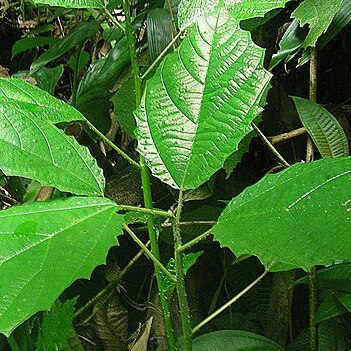A scandent, usually sparingly pubescent and hirsute urticating perennial herb up to 2 m. high when supported.. Petiole (0.5–)1–6 cm. long, evenly to sparingly pubescent; blade oblong-lanceolate to narrowly lanceolate, (2–)4–10(–12) cm. long, 0.7–5 cm. wide, acute, cuneate, rounded, truncate or very shallowly cordate, serrate, sometimes shallowly so, thinly chartaceous, 3–5(–7)-nerved from the base, lateral nerves 5–9 pairs, sparingly hirsute along the midrib and main nerves above and beneath, otherwise ± glabrous, sometimes purplish tinged.. Stipules lanceolate, 4–5 mm. long, acute, ± glabrous except on the margins.. Inflorescences lateral and/or supra-axillary, (1.5–)2.5–4.5 cm. long, lax-flowered; axis slender, sparingly pubescent; ♂ and ♀ bracts lanceolate, 1 mm. long, sparingly pubescent, persistent; bracteoles resembling the bracts.. Male flowers: pedicels 1.5–2 mm. long, persistent; calyx-lobes 3, ovate, 0.75 mm. long, ± glabrous, reddish; stamens 0.3 mm. long, filaments short, thick, anthers minute, extrorse, yellowish; pistillode minute or 0.. Female flowers: pedicels 2–4 mm. long, densely pubescent at first, rapidly extending to 2–4(–5) cm. long in fruit, and becoming sparingly pubescent; calyx-lobes 6, lanceolate, 1.5 mm. long, accrescent to 2 mm. in fruit, subglabrous, reddish, persistent; ovary trilobate, 1 mm. diameter, densely setose; styles 3, 1.5 mm. long, united for ± half their length, glabrous, the lobes recurved, stigmatic surfaces papillose.. Fruits dimorphic; normal fruits strongly trilobate, 3 mm. long, 6 mm. diameter, with the keel of each coccus slightly gibbous, evenly setose and pubescent, the keels purplish; allomorphic fruits monococcous, each provided with 3 strongly developed sharp spinous outgrowths.. Seeds 2 mm. diameter, reddish brown, mottled buff.
Armed with stinging hairs.
A slender twiner

